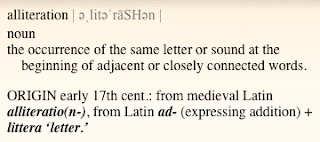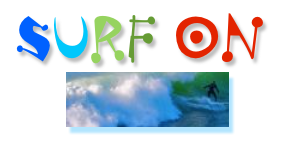
As of this year the second Monday of the month is dedicated to my writing workshop students and anyone else interested in creative writing.
Poetic alliteration is one of the many techniques you can use to make your writing more vivid and powerful. The definiton of alliteration: “The occurrence of the same letter or sound at the beginning of adjacent or closely connected words.”

From (of all things) a movie review by Desson Howe in the Washington Post:
“There he is, in all his glory, Brad Pitt, that beautiful, chiseled chunk of celebrity manhood. You want him? Go see Fight Club. You want action, muscle, and atmosphere? You want boys bashing boys in bloody, living color? Fight Club is your flick, dude.”
To start with, we have “chiseled chunk” — ch and then ch
In the fourth sentence we have “action, muscle, and atmosphere”– ah and ah
Then “boys bashing boys in bloody, living color”– b, b, b, and b
Then “Fight Club is your flick, dude” — f and f
The point: the sound of the words– alliteration– reinforces the meaning.
#
More examples:
“…hold on with a bull-dog grip and chew and choke as much as possible”
— Letter, President Lincoln to General Grant
“When somebody threatens me, he says, I usually tell them to pack a picnic and stand in line.”
— Mikey Weinstein quoted in Marching As to War by Alan Cooperman
“A competitor once described [mining engineer Frank Holmes] as ‘a man of considerable personal charm, with a bluff, breezy, blustering, buccaneering way about him’ “
— Daniel Yergin, The Prize
“Small heart had Harriet for visiting”
— Jane Austen, Emma
#
As I cannot repeat often enough, as a writer, your best teachers are the books you have already read and truly loved– the books that made you want to write your own. (These books or may not get the Seal of Approval from your English professor– but never mind. Some academics may be artists, and some artists academics, but in general they are creatures as different from one another as a coyote and a horse.)
To repeat: As a writer, your best teachers are the books you have already read and truly loved. Pull one of those beloved books off your bookshelf, have a read-through, see where and how the author uses alliteration. Or not?
Once you recognize a technique you can often spot it in, say, a newspaper article, a biography, or an advertisement. More about reading as a writer here.
Help yourself to more resources for writers on my Resources for Writers page.

Blast Past Easy: A Permutation Exercise with Clichés
Working with a Working Library: Kuddelmuddel
Find out more about C.M. Mayo’s books, shorter works, podcasts, and more at www.cmmayo.com.

